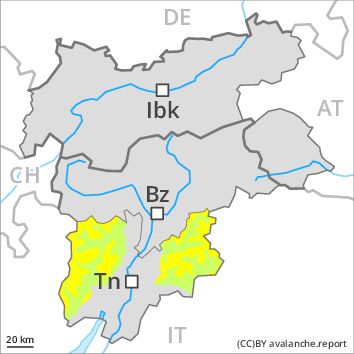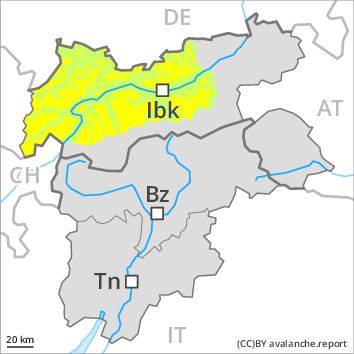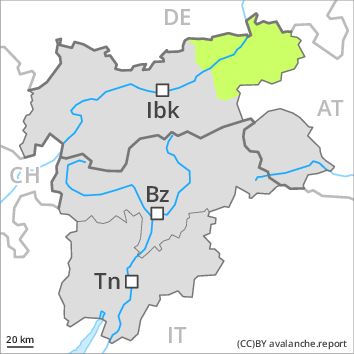Regions
Prealps, Cembra Valley, Bondone and Stivo, Vallarsa, Western Nonsberg Alps, Folgaria - Laverone, Ledro Valley, Paganella, Marzola - Valsugana, Pine' - Mocheni Valley

Danger level
Danger Level 2 - Moderate above the treeline
Danger Level 1 - Low above the treeline
Avalanche Problem
Wind-drifted snow above the treeline, N-NE-E-SE-S-SW-W-NW
Favourable situation above 2000m

Fresh snow and wind slabs above the tree line. The snowpack will be in most cases well bonded.
The mostly small wind slabs of the last few days can be released, especially by large additional loads, in all aspects above the tree line. In some places fresh snow and wind slabs are lying on an icy crust. Even in moderately steep terrain there is a danger of falling on the icy crust.
Snowpack
dp 6: cold, loose snow and wind
The fresh wind slabs are rather small and can be released by large loads in particular. These are clearly recognisable to the trained eye. The older wind slabs have bonded quite well with the old snowpack. The snowpack will be stable in particular in shady places that are protected from the wind. In some places fresh snow and wind slabs are lying on an icy crust.
Tendency
Gradual decrease in danger of gliding avalanches and snow slides as the temperature drops.
Regions
Southern Adamello, Primiero - Pale di S. Martino, Adamello - Presanella, Northern Brenta - Peller, Southern Brenta, Fassa Valley, Southern Lagorai, Sole, Pejo and Rabbi, Northern Lagorai, Latemar, Maddalene

Danger level
Danger Level 2 - Moderate above the treeline
Danger Level 1 - Low above the treeline
Avalanche Problem
Wind-drifted snow above the treeline, N-NE-E-SE-S-SW-W-NW
Gliding snow above 2600m, E-SE-S-SW-W

Fresh wind slabs require caution.
The fresh wind slabs must be evaluated with care and prudence in all aspects above the tree line. They are mostly easy to recognise but can be released easily. In the regions exposed to heavier precipitation caution is to be exercised in particular in gullies and bowls, and behind abrupt changes in the terrain. At high altitudes and in high Alpine regions avalanche prone locations are more prevalent. Individual gliding avalanches are possible, but they can reach medium size, especially in the regions with a lot of snow below approximately 2600 m. Areas with glide cracks are to be avoided as far as possible.
Snowpack
dp 6: cold, loose snow and wind
dp 2: gliding snow
The wind has transported the fresh snow significantly. The fresh wind slabs are clearly recognisable to the trained eye. These are lying on soft layers in particular on shady slopes above the tree line. The older wind slabs have bonded quite well with the old snowpack.
The old snowpack will be moist below the tree line.
Tendency
Gradual decrease in danger of gliding avalanches and snow slides as the temperature drops.
Regions
Sexten Dolomites, Val Müstair Alps, Langtaufers, Schnals Ridge, Southern Stubai Alps, Southern Zillertal Alps and High Tauern, Saldurn-Mastaun Ridge, Texel Mountains, Sarntal Alps, Western Pfunderer Mountains, Glockturm Range, Eastern Pfunderer Mountains, Durreck Range, Weißkugel Range, Western Rieserferner Mountains, Gurgler Range, Western Deferegger Alps, Central Stubai Alps, Ortler Range, Northern Zillertal Alps, Ulten Valley, Venediger Range, Eastern Nonsberger Alps, Eastern Rieserferner Mountains, Northern Dolomites of Fiemme, Glockner Range, Gröden Dolomites, Eastern Deferegger Alps, Prags Dolomites, Schober Mountains, Lienzer Dolomites

Danger level
Danger Level 2 - Moderate above the treeline
Danger Level 1 - Low above the treeline
Avalanche Problem
Wind-drifted snow above the treeline, N-NE-E-SE-S-SW-W-NW
Gliding snow above 2600m, E-SE-S-SW-W

Fresh wind slabs require caution.
The fresh and somewhat older wind slabs are to be found in particular adjacent to ridgelines and in gullies and bowls in all aspects. These are to be evaluated with care and prudence above the tree line. At high altitudes and in high Alpine regions avalanche prone locations are more prevalent. The avalanche prone locations are sometimes covered with fresh snow. This applies in particular in the regions exposed to heavier precipitation. The wind slabs are mostly small but prone to triggering.
Only isolated gliding avalanches are possible, but they can reach medium size, especially in the regions with a lot of snow below approximately 2600 m. Areas with glide cracks are to be avoided as far as possible.
Snowpack
dp 6: cold, loose snow and wind
dp 2: gliding snow
At high altitudes and in high Alpine regions the wind was moderate to strong at times. The wind has transported the fresh and old snow. The sometimes large wind slabs are lying on soft layers. Ortler Range, Weißkugel Range, Gurgler Range and Central Stubai Alps: More recent wind slabs are covered with fresh snow in some cases and therefore difficult to recognise, in particular in places that are protected from the wind. The older wind slabs have bonded quite well with the old snowpack.
The old snowpack will be moist below the tree line.
Tendency
Hardly any decrease in avalanche danger.
Regions
Western Verwall Mountains, Eastern Verwall Mountains, Allgäu Alps, Silvretta, Samnaun Mountains, Eastern Lechtal Alps - Ammergau Alps, Northern Oetz and Stubai Alps, Mieming Mountains, Western Tuxer Alps, Karwendel Mountains, Eastern Tuxer Alps, Western Lechtal Alps, Central Lechtal Alps, Grieskogel Mountains

Danger level
Danger Level 2 - Moderate above the treeline
Danger Level 1 - Low above the treeline
Avalanche Problem
Wind-drifted snow above the treeline, N-NE-E-SE-S-SW-W-NW
Gliding snow above 2400m, N-NE-E-SE-S-SW-W-NW

Wind slabs above the tree line. Gliding avalanches and snow slides require caution.
The fresh wind slabs represent the main danger. The fresh and somewhat older wind slabs are to be found in particular adjacent to ridgelines and in gullies and bowls in all aspects. These are to be evaluated with care and prudence above the tree line. At high altitudes and in high Alpine regions avalanche prone locations are more prevalent. They are sometimes covered with fresh snow and are barely recognisable for beginners. In places that are protected from the wind the situation is more favourable. The more recent wind slabs can be released even by a single winter sport participant. Avalanches are rather small.
Areas with glide cracks are to be avoided as far as possible.
Snowpack
dp 6: cold, loose snow and wind
dp 2: gliding snow
Up to 10 cm of snow. fell. The sometimes strong wind will transport the snow. In some places wind slabs are lying on soft layers. As the day progresses the wind slabs will increase in size moderately. The fresh wind slabs are covered with fresh snow in some cases and therefore difficult to recognise. They are mostly small. The older wind slabs have bonded well with the old snowpack. Over a wide area fresh snow and wind slabs are lying on a hard crust. The old snowpack will be moist below the tree line.
Tendency
Hardly any decrease in avalanche danger.
Regions
Brandenberg Alps, Western Kitzbühel Alps, Wilder Kaiser Mountains - Waidring Alps, Eastern Kitzbühel Alps

Danger level
Danger Level 1 - Low
Avalanche Problem
Wind-drifted snow above 2200m, N-NE-NW
Gliding snow above 2600m, E-SE-S-SW-W

Fresh wind slabs at high altitude. Slides can occur on steep grassy slopes.
Thus far only a little snow is lying. Individual avalanche prone locations for dry avalanches are to be found in particular on very steep shady slopes above approximately 2200 m, especially adjacent to ridgelines. Such avalanche prone locations are rare and are easy to recognise. Individual gliding avalanches and moist snow slides are possible.
Snowpack
dp 6: cold, loose snow and wind
dp 2: gliding snow
The snowpack will be in most cases stable. Over a wide area fresh snow and wind slabs are lying on a hard crust. At low and intermediate altitudes hardly any snow is lying.
Tendency
Low, level 1.





